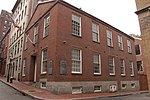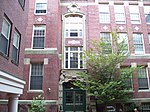African Meeting House
1806 establishments in Massachusetts19th century in BostonAbolitionism in the United StatesAfrican-American history in BostonAfrican-American museums in Massachusetts ... and 13 more
Asher Benjamin buildingsBaptist churches in BostonBeacon Hill, BostonChurches completed in 1806Churches on the National Register of Historic Places in MassachusettsChurches on the Underground RailroadCulture of BostonFirst African Baptist churchesHistoric district contributing properties in MassachusettsMuseums in BostonNRHP infobox with nocatNational Historic Landmarks in BostonNational Register of Historic Places in Boston

The African Meeting House, also known variously as First African Baptist Church, First Independent Baptist Church and the Belknap Street Church, was built in 1806 and is now the oldest black church edifice still standing in the United States. It is located in the Beacon Hill neighborhood of Boston, Massachusetts, adjacent to the African-American Abiel Smith School. It is a National Historic Landmark.
Excerpt from the Wikipedia article African Meeting House (License: CC BY-SA 3.0, Authors, Images).African Meeting House
Smith Court, Boston Beacon Hill
Geographical coordinates (GPS) Address Website Nearby Places Show on map
Geographical coordinates (GPS)
| Latitude | Longitude |
|---|---|
| N 42.359983333333 ° | E -71.065480555556 ° |
Address
Museum of African American History (African Meeting House Museum of African American History)
Smith Court
02114 Boston, Beacon Hill
Massachusetts, United States
Open on Google Maps








